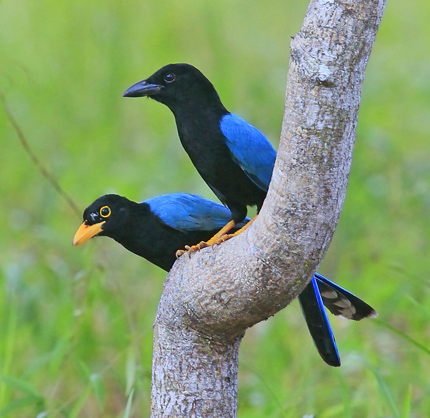
Yucatan Jays. Photo: Bob Gress - Birding Belize
Belize is quite simply a birder’s paradise. Formerly known as British Honduras, this small Central American country is a popular destination for tourists. Bordered on its western side by Mexico and Guatemala, and on the east by the Caribbean Sea (and the second-longest barrier reef in the world), Belize forms the northern part of the Mesoamerican Biological Corridor which stretches from Mexico to Panama. Belize has a small human population, which ensures there are still extensive areas of native habitat to be found. In fact, some 60% of the country is covered by forest. In addition, Belize has been proactive in protecting its natural resources, and today some 37% of its native habitat falls under some level of protection.
Our tour takes us all around this little gem of a country; from Crooked Tree and La Milpa in the north; to the Caracol and Mountain Pine Ridge in the west; Blue Hole NP in the center of the country; and Mayflower Bocawina National Park in the south and east. The ancient Maya culture is writ large across the landscape of Belize, and we’ll spend a day amid the wonderful ruins at Caracol, as well as lesser known archaeological sites. With some delightful lodges, easy trails through productive habitats, and a number of scintillating birds, we are assured a wonderful birding tour – you better Belize it!
Day 1: The tour begins midday at the Belize airport. After clearing immigration and customs you’ll be met by your local guide to begin the tour. Flights are often staggered throughout the day and the nearby Captain Hook’s Shrimp Farm and Wildlife Sanctuary will offer an opportunity to enjoy some cold limeade, fresh ceviche, and some easy birding while we wait for everyone to arrive. The mangrove forests surrounding the shrimp farm can host a number of Caribbean specialties, so we’ll spend some time looking for Black Catbird, Yucatan Vireo, and Mangrove Cuckoo (to name just a few). After everyone arrives we’ll drive north along the Northern Highway to Crooked Tree village, located inside the eponymous wildlife sanctuary, where we’ll spend the next two nights. Night near Crooked Tree.
Day 2: The Crooked Tree Sanctuary was founded in 1984 by the Belize Audubon Society and consists of some 16,000 acres of inland waterways, swamps and lagoons. The wetland is approximately a mile wide and more than 20 miles long and the reserve features a number of trails allowing for exploration on foot. We will spend most of the day birding along these trails and exploring nearby forest patches by vehicle where a wide variety of birds can be expected. The many waterways offer an opportunity to encounter Jabiru, and Pinnated Bittern, both of which are very difficult to find elsewhere in Central America, as well as dozens of other waterbirds. The treetops along the edge of the lagoons can harbor Black-collared Hawk, and the low aquatic vegetation offers perches for Snail Kites, who are there feeding on apple snails.
Once away from the water, in the nearby pine woodlands, we’ll search for many species of birds that are endemic to the Yucatan Peninsula including Yellow-headed and Yellow-lored Parrots, Yucatan Woodpecker, Yucatan Flycatcher, Yucatan Jay, as well as many other regional endemics. The trails around the lodge often turn up a Gray-throated Chat or two. As dusk approaches we may venture out to look for Yucatan Poorwill. Night near Crooked Tree.
Day 3: We’ll enjoy a magical, early-morning boat trip cruising gently along the Crooked Tree Lagoon and up Spanish Creek where we stand a good chance of getting close to shy species such as Jabiru, Sungrebe, both Agami and Boat-billed Herons, and American Pygmy Kingfisher.
After breakfast, we’ll depart for La Milpa, crossing open savannah, rice paddies, and dry farmland, before eventually driving through mature hardwood forest. There will be many birds to enjoy along the drive; in fact, so many so that it’s often difficult to get anywhere. We promise to stop for at least the first five Fork-tailed Flycatchers. Once we arrive at La Milpa we’ll get settled in our rooms and enjoy an evening walk around the grounds before dinner. The lawn around the dining area often hosts a large flock of Ocellated Turkeys, and one or two pairs of Great Curassows. Night near La Milpa.
Day 4: The lodge at La Milpa, nestled deep in the forests of northwestern Belize, is located only a short distance from the La Milpa Archaeological Site, which is the third largest in Belize and one of at least 60 other archaeological sites found in the Rio Bravo area. We’ll look for birds throughout the day on the many trails in the area as well as at fruit and compost feeding stations. It is not uncommon to see over 100 species of forest birds on this day of the tour. A highlight of today will no doubt be enjoying morning coffee while watching dozens upon dozens of honeycreepers, tanagers, and wood-warblers flitting about between the fruit feeders and the water stations. In the evening we’ll do a bit of owling around the lodge before going for a night drive in the area – Jaguar and Tapir have both been spotted in the area many times. In years past our group has seen Gray Fox and Ocelot. Night near La Milpa.
Day 5: We’ll spend the first part of the day birding the grounds of the lodge, cleaning up on anything we missed the morning before, and taking one last look at the hummingbird feeders which often attract White-necked Jacobin, Wedge-tailed Sabrewing, and White-bellied Emeralds, among others. Leaving after breakfast we’ll take a route following backroads, across many private ranches, and through some of the healthiest and most remote forests in western Belize. Along the way we have a real chance of encountering interesting mammals such as White-tailed and Red Brocket Deer, and White-lipped and Collared Peccaries. In these forests we can at least dream of Jaguar, Puma, and Margay. There will be birds to look for as well; Laughing Falcon, Crested Guan, Black Hawk-Eagles, Double-toothed Kite, and Great Black Hawk have all been seen on this route. Brown-hooded and Mealy Parrots are often seen blasting across the sky overhead. We’ll have lunch along for the drive so we can make the best of the birding, and we’ll arrive at our lodge with plenty of time to look for the resident Emerald Toucanets, enjoy the birds coming to the fruit feeders, and scope for the nesting pair of Black-and-white Hawk-Eagles. Night near San Ignacio.
Day 6: Today is our halfway point and we’ve reserved it for leisurely birding around the grounds of our lodge or just taking some time off to enjoy a stroll through the organic garden or to take a dip in the pool. The lodge’s observation deck overlooks the fast-flowing Macal River, while steep limestone cliffs and thick forest make for a gorgeous backdrop for hawk-watching while enjoying the many birds coming to the fruit feeders. This is one of the best places in Central America to encounter Black, Ornate, and Black-and-white Hawk-Eagles, while White Hawks and King Vultures are often plentiful. After a day of easy birding and recuperation we’ll do a bit of owling near the lodge in hopes of finding Mottled and Middle American Screech-Owl. Night near San Ignacio.
Day 7: We’ll leave early and spend much of today in the Mountain Pine Ridge Reserve, a large park dominated by Honduras Pines, with smaller patches of broad-leaved forest and grassland interspersed. A fine selection of birds awaits us here including Yellow-faced Grassquit, Rufous-capped Warbler, Yellow-backed Oriole, Golden-hooded Tanager, Lovely Cotinga, Red Crossbill, Black-headed Siskin, and Grace’s Warbler. In the afternoon we’ll visit the very impressive Thousand Foot Falls where we’ll devote some time to scanning cliffs and treetops for the endangered Orange-breasted Falcons that nest near the falls. Stygian Owl has been found roosting in this area on more than one occasion, so we’ll devote a bit of time to checking roost sites before heading back to the lodge for dinner. Night near San Ignacio.
Day 8: Today we’ll drive to Caracol! It was in 1937 that a logger came across these hidden Maya remains deep in the jungle. Subsequent excavations revealed a huge site covering some 75 square miles and containing a wealth of ancient buildings, including the highest man-made structure in Belize today – the Caana Sky Palace. We’ll take time to explore the ancient site, and to look for many of the birds that make this location their home including Keel-Billed Motmot, Crested Guan, Great Curassow and the fabulous Ocellated Turkey.
Nearby pools are attractive to a variety of birds including Tody Motmot, Buff-throated Foliage gleaner, Black-cheeked Woodpecker, Golden-hooded Tanager, Ruddy-tailed Flycatcher, Rufous Piha, Rusty Sparrow, Olive and Green-backed Sparrows, Bat Falcon, Gray-headed Kite, and Great Black Hawk. Some years we encounter large flocks of Scarlet Macaws moving between feeding and nesting areas nearby. Night near San Antonio.
Day 9: We’ll depart in the morning heading for the Mayflower Bocawina National Park. On the way we’ll stop at Blue Hole National Park for some birding. Besides the famous blue hole – a deep limestone pool set in the forest – there are a number of hiking trails which we’ll explore in hopes of finding Purple-crowned Fairy, Spotted-Wood Quail, Crested Guan, Northern Royal and Sulphur-rumped Flycatchers, Barred, and Great Antshrikes, Emerald Toucanet, Slaty-tailed Trogon, and Orange-billed Sparrow. Night in Hopkins Village.
Days 10-11: We have two days to explore this region. A short drive takes us to the Mayflower Bocawina National Park, consisting of over 7,000 acres of superb forest habitat. It is home to waterfalls, lush vegetation and fabulous bird diversity such as Keel-billed and Tody Motmots, Black-faced Antthrush, Little and Slaty breasted Tinamous, Ruddy Quail Dove, Black-and-white and Spectacled Owls, American Pygmy Kingfisher, Cinnamon and White-winged Becards, Yellow-bellied Tyrannulet, and Tawny-crowned Greenlet, among hundreds of others.
We’ll spend a morning birding in the Jaguar Reserve where we hope to see Crested Guan, White-collared Manakin, Scarlet-rumped (formerly Passerini’s) Tanager, Crimson-collared Tanager, Hook-billed Kite, Rufous-breasted Spinetail, Orange-billed Sparrow, Black-faced Grosbeak, Chestnut-headed Oropendola, Dot-winged Antwren, and Dusky Antbird. Well over 200 species of birds have been recorded here, so we are guaranteed a bird-filled ending to our trip. Nights in Hopkins Village.
Day 12: We have a leisurely return to Belize International Airport where the tour ends.
Updated: 31 May 2024
Prices
- 2025 Tour Price : $5,550
- Single Occupancy Supplement : $1,050
Notes

Questions? Tour Manager: Stephanie Schaefer. Call 1-866-547-9868 (US or Canada) or (01) 520-320-9868 or click here to email.
* Tour invoices paid by check carry a 4% discount. Details here.
Maximum group size 10 with two leaders.
